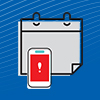Blog
Infographic: point vs platform solutions in healthcare communications

Are numerous, disjointed communication and IT solutions creating challenges at your hospital?
You’re not alone.
Many healthcare organizations are cobbling together their clinical communications from several vendors and grappling with the resulting costs and frustrations. Often, each department purchases, maintains, and rolls out separate solutions. With multiple technologies solving each communication need, it’s difficult to create an entire care team collaboration ecosystem.
We call this a point-solution approach.
A more holistic view of healthcare communications is possible with a platform solution.
The idea of a platform solution is familiar to many hospitals. A 2018 study found that 90% of hospitals are making “significant enterprise-wide investments in smartphones and secure mobile communications platforms.” Perhaps less familiar, though, is the idea of a complete, enterprise-wide, and fully-integrated communication platform that supports every department, role, and device.
Let’s break it down into two simple definitions
Platform: A complete end-to-end solution with seamless interoperability that provides the situational awareness required to be fully real time and patient-centric.
Point solution: Addresses and delivers on one specific need, often functioning in isolation and only solving a small piece of a very complex puzzle.
There are five key differences between a point and platform solution to support healthcare collaboration and communications. Download the infographic to learn more.
Check out the infographic
Highlights from the infographic include:
- The differences between using point solutions vs a platform for healthcare communication and collaboration.
- The potential benefits of each solution.
- The average activation time for a code STEMI using point solutions vs a communications platform.
- How Franciscan Health Michigan City, a full-service hospital in Michigan City, Indiana, cut code initiation time in half by using a platform solution.
By focusing on a platform solution for clinical communication and collaboration, today’s hospital IT leaders can connect people and workflows across the organization. It also allows for a variety of integration and interoperability options to share data and functionality with hospital systems key to patient care, like the EHR, nurse call, patient monitoring networks, and the contact center.
If you’re looking for more information on the benefits of a platform solution, you might also be interested in our free eBook: Healthcare Guide to Platform vs. Point Solutions.






